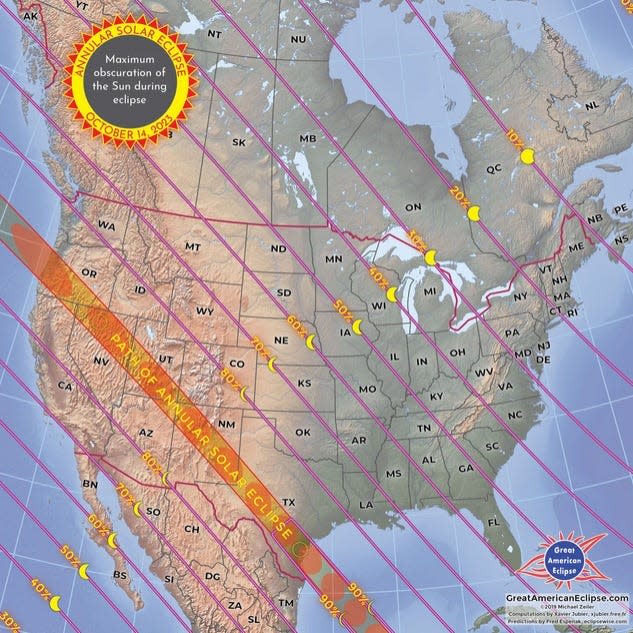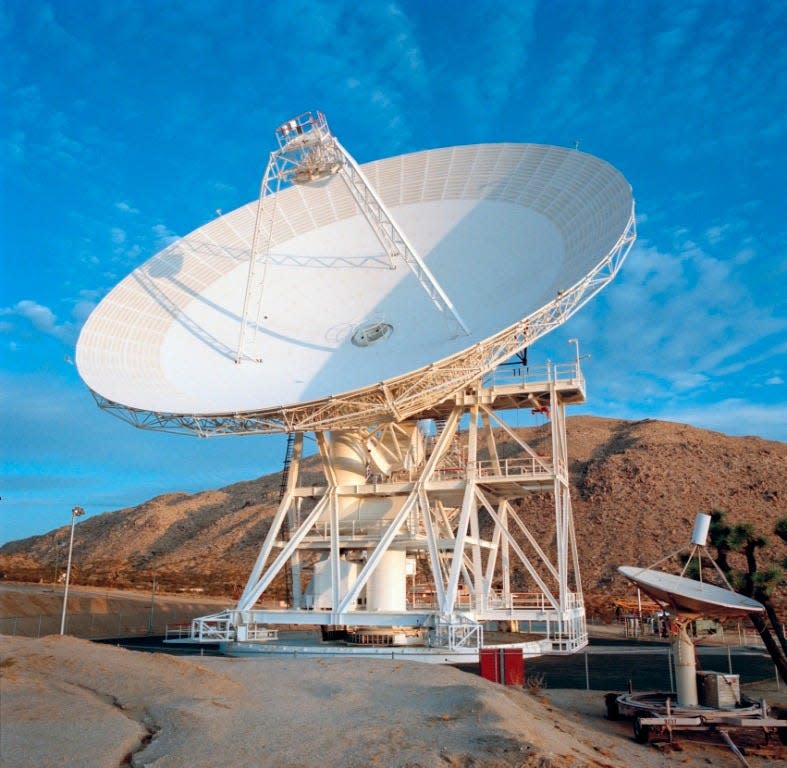How much of Saturday’s annular solar eclipse will be seen High Desert?
A solar eclipse will happen this weekend, and weather permitting, most of California will have the opportunity to view a portion of it.
On Saturday, the moon will pass between earth and sun, giving people across the U.S. an opportunity to see an annular solar eclipse. The main path of the solar eclipse includes portions of several states, including Oregon, Nevada, Utah, Arizona, Colorado, New Mexico, Texas, and the northern tip of California.
The eclipse should start to be visible on the Oregon coast around 8 a.m. as it moves in a south-easterly direction.
The National Weather Service said the prime eclipse viewing time is at 9:26 a.m., with those in the mountains and deserts having a better chance to see the event due to less cloud coverage.

High Desert residents who look to the east Saturday morning will be treated to a partial solar eclipse with just under 80% of the sun blocked out by the moon at the eclipse’s peak.
In California, if you want the best view of the ring of fire, you’ll need to drive up to Modoc County, according to SFGate.
“Hotels and campsites are already pretty well booked, and the sparsely populated corner of Northern California is expecting a surge in tourists this weekend,” SFGate reported.
NASA will host live coverage of the eclipse starting at 11:30 a.m. EDT. on NASA Television, the agency’s website, and the NASA app. NASA will stream the broadcast live on its Facebook, X, and YouTube social media accounts.

Lewis Center for Education Research
The Lewis Center for Education Research in Apple Valley will partner with NASA's Jet Propulsion Laboratory to monitor Saturday’s eclipse and one in 2024.
The project is led by researchers at different academic institutions and will study the sun and its influence on Earth with various instruments. It is one of five interdisciplinary science projects funded by NASA.
"Seven years after the last American total solar eclipse, we're thrilled to announce the selection of five new projects that will study the 2024 eclipse," said Peg Luce, acting director of the Heliophysics Division in the Science Mission Directorate at NASA Headquarters in Washington. "We're excited to see what these new experiments will uncover about our Sun and its impact on Earth."
The opportunity comes from a NASA grant to the Goldstone Apple Valley Radio Telescope (GAVRT) team based at the Lewis Center and its Solar Patrol campaign, the space agency announced. The telescope is located at the Goldstone Deep Space Communications Complex near the Fort Irwin National Training Center, north of Barstow.
Under the direction of JPL scientist Dr. Thangasamy Velusamy, GAVRT “citizen scientists” will use the 34-meter telescope to measure subtle changes to radio emissions from solar “active regions” during the October 2023 annular and April 2024 total eclipses.

Solar eclipse 2023
Also known as a ring of fire eclipse, an annular solar eclipse happens when the moon is at or near its farthest point from Earth, according to NASA.
Because the moon is farther away than it is during a total solar eclipse, the moon appears smaller and doesn’t block out the entire sun when it passes in front of our star. Instead, the moon leaves a bright ring of sun visible at the eclipse’s peak, creating the ring of fire effect.
This eclipse will also be visible in Puerto Rico and parts of Alaska and Hawaii. The areas will see a partial solar eclipse when part of the sun is covered by the moon without creating the ring of fire effect.
Eclipse 2024
The next solar eclipse takes place on April 8, 2024, when a total solar eclipse will cross the U.S. from Texas to Maine. During this event, a partial solar eclipse will be visible throughout the contiguous U.S., as well as in Puerto Rico and parts of Alaska and Hawaii.
Learn more about the Oct. 14 eclipse at go.nasa.gov/Eclipse2023.
Daily Press reporter Rene Ray De La Cruz may be reached at 760-951-6227 or RDeLaCruz@VVDailyPress.com. Follow him on Twitter @DP_ReneDeLaCruz
This article originally appeared on Victorville Daily Press: How much of Saturday’s annular solar eclipse will be seen High Desert?

